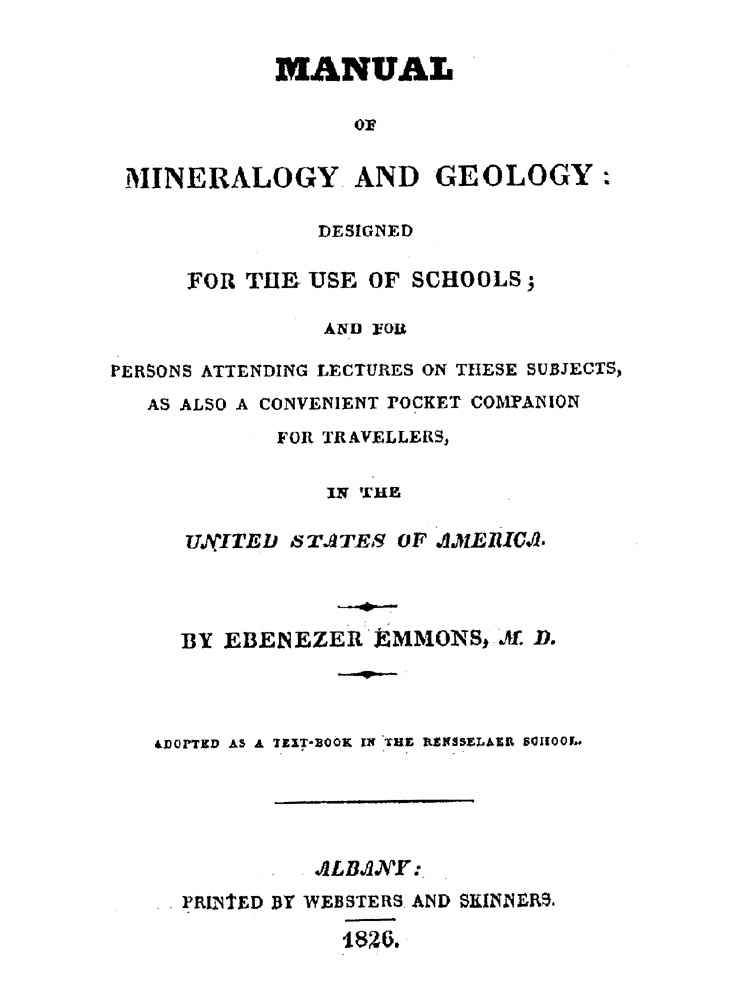EMMONS, Ebenezer.
(1799 – 1863)
Born the son of a farmer, Emmons attended the Rensselar Polytechnic Institute. There he became an assistant of the American geologist Amos Eaton [1776-1842]. After graduating in 1826, Emmons opened a medical practice specializing in obstetrics in Chester, Mass. From 1828 to 1834, he delivered lectures in chemistry at Williams College. This lead in 1833 to an appointment as professor of natural history, a position he held until 1859, at which time Emmons was made professor of geology and mineralogy.
As an author, Emmons wrote on agriculture, geology and mineralogy. His most important book was Geology ... of the Second Geological District, which was issued as part of Division 4 of the Natural History of New York (4 vols., Albany, 1842). In this work, Emmons created the first comprehensive picture of the geology of New York by devising his own influential system of geological classification.
Biographical references: ABA: I 506, 82-89. • American Chemists & Chemical Engineers: 2, 85-6 [by W.D. Miles]. • Appleton Cyclopedia of American Biography. • Barr, Index to Biographical Fragments, 1973: 79. • Cleevely, World Palæontological Collections, 1983: 111. • DAB: 3, 149 [by G.P. Merrill]. • Drake, Dictionary of American Biography, 1872. • DSB: 4, 363-5 [by C.J. Schneer]. • Elliott, Biographical Index, 1990: 73. • Elliott, Biographical Dictionary, 1979: 87. • Encyclopaedia Britannica, 11th edition. • Herringshaw's National Library of American Biography. • Ireland, Index to Scientists, 1962: 202. • Lambrecht & Quenstedt, Catalogus, 1938: 128. • National Cyclopedia of American Biography. • Poggendorff: 3, 408. • Sarjeant, Geologists, 1980: 2, 957-8. • Sarjeant, Geologists, Suppl. 1, 1986: 1, 407. • WBI. • World Who's Who in Science: 523.

1. English, 1826 [First edition].
Manual | of | Mineralogy and Geology: | designed | for the use of schools; | and for | persons attending lectures on these subjects, | as also a convenient pocket companion | for travellers, | in the United States of America. | [ornate rule] | By Ebenezer Emmons, M.D. | [ornate rule] | Adopted as a Text-Book in the Rensselaer School. | [rule] | Albany: | Printed by Websters and Skinners. | [rule] | 1826.
12° (in 6s): 1-26 A-B6 3-186 197; 127l.; [i]-xxiii, [1], [1]-229, [1] p. Page size: 178 x 104 mm.
Contents: [i-ii], Title page, verso "Northern District of New York. ..."; [iii]-v, "Preface."; [vi], Blank.; [vii]-xxiii, "Tabular View of the Arrangement Adopted in this Work."; [1 pg], Blank.; [1]-22, "Introduction to the Study of Mineralogy."; [2 pgs], Blanks.; [25]-178, Text of descriptive mineralogy.; [179]-181, "Introduction to the Study of Geology."; [182], "Arrangement of Rocks."; [183]-206, "General Description of North American Rocks."; 207-211, "Explanation of Terms, &c. Commonly used in mineralogical and geological descriptions."; [212]-222, "Table of Synonymes."; [223]-229, "Index."; [1 pg], Addenda and errata.
Very scarce. After Cleaveland's encyclopedic Treatise appeared in 1816 and 1822, many people began to have an interest in the minerals of the United States, and from this interest demand arose for a short, simple, descriptive mineralogy. Although Cleaveland's work was a comprehensive reference, it was to bulky and expensive to readily be used as a field guide. Under these conditions Emmons published his Manual to favorable response.
The book adopts the classification of Mohs but substitutes Brooke's system of crystallography. The individual mineral descriptions are clear and concise, giving the user ample general information while stressing known localities in the United States. Unfortunately use as a textbook undoubtedly caused many copies of this book to quickly dilapidate making both this edition and the second rare collectibles.
Bibliographical references: BL [no copy listed]. • Hazen & Hazen, American Geological Literature, 1980. • NUC. • Roller & Goodman, Catalogue, 1976: 1, 361. • Ward & Carozzi, Geology Emerging, 1984: no. 743.
2. English, 1832 [2nd edition].
Manual | of | Mineralogy and Geology. | [rule] | By | Ebenezer Emmons, M.D. | Lectuer on Chemistry and Natural History in Williams College. | [rule] | Second Edition. | [rule] | Albany: | Webster and Skinners. | [rule] | 1832.
12° (in 6s): π6 1-256; 156l.; [2], [i]-v, [1], [ix]-xii, [1]-299, [1] p. Page size: 184 x 110 mm.
Contents: [2 pgs], Half title page, "Manual of Mineralogy and Geology," verso blank.; [i-ii], Title page verso "Entered according to Act of Congress, in the year 1832, ..."; [iii]-v, "Preface | To The Second Edition."-signed E. Emmons, August 1832.; [1], Blank.; [ix]-xii, "Table of Contents."; [1]-269, Text.; [270], Blank.; [271]-288, "Notes Referred to in the Introduction to Mineralogy."; [289]-299, "Index."; [1 pg], Blank.
Scarce. A thoroughly revised text which is more useable than the first attempt. In preparing this edition, Emmons has remodeled its content to facilitate instruction in the science of minerals. It was his intent to supply the student with a guide so they could satisfactorily conduct through the process of examining minerals. To facilitate this, the text included sufficient information to employ the characters of minerals substances and to trace the relations existing between the various species. The classification system of F. Mohs has like the first edition again been adopted. For crystallography, the system of H.J. Brooke is retained. Emmons has included a few woodcuts to illustrate the crystalline forms, which was lacking from the previous edition.
The short introduction provides an overview of the definition and purpose of mineralogy. A section describing the terminology used in the crystallographic description follows. The optical and physical properties of minerals are reviewed. The theory of classification, nomenclature, characteristics and a description of physiography precede the large section devoted to descriptive mineralogy. An index concludes the work.
Bibliographical references: American Journal of Science: 1st Series, 24 (1833), 397. • BL [no copy listed]. • Hazen & Hazen, American Geological Literature, 1980. • NUC. • Roller & Goodman, Catalogue, 1976: 1, 361.
.